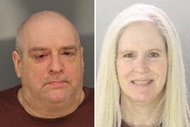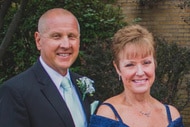How Echoes Of The Bernie Goetz Subway Shooting Still Resonate Today
The 1984 shooting of Troy Canty, Barry Allen, James Ramseur, Darrell Cabey sparked debates that remain relevant.

It was a case that wouldn't seem out of place today. On Dec. 22, 1984, four black teens approached a white man on a New York City subway train and either asked for or demanded money. The man, who'd been mugged before and would later tell authorities he felt threatened, almost immediately pulled a handgun out of his jacket and began firing, striking and wounding all four teens. The criminal case that followed, and the national debate it stirred, raised questions about self-defense, vigilantism, and race that have been eerily echoed numerous times in the decades since.
The case of Bernhard “Bernie” Goetz and his shooting of Troy Canty, Barry Allen, James Ramseur, and Darrell Cabey is explored in the second episode of “Trial By Media” — a six-episode Netflix docuseries that focuses on highly publicized trials and how the conversations around them are shaped.
Goetz would later recount how, after the teens approached him on a southbound 2 train at around 14th St., he visualized the pattern in which he'd fire off rounds, then methodically proceeded to do so. Two of the teens were shot in the back, and Goetz later told authorities he shot one of them twice because the teen didn't seem hurt enough.
Goetz, a 37-year-old engineer who operated a small electronics company out of his Greenwich Village apartment, told a train conductor in the immediate aftermath that the teens — Ramseur was 18 and the rest of his friends were 19 — were trying to mug him. Canty and Ramseur later testified that they were just panhandling and had asked Goetz for $5.
As the "Trial By Media" episode shows, the teens, who had all been arrested in the past for minor offenses, were almost immediately assumed to be criminals and vilified by some in the public. The four became symbols of rampant crime in New York City, which at the time was in the midst of the crack cocaine epidemic. Many New Yorkers who were tired of being crime victims expressed a kinship with Goetz for seemingly fighting back. The press even dubbed him the ‘Subway Vigilante” and compared him to Charles Bronson’s character in the 1974 movie “Death Wish.” In the film, Bronson plays a New York City architect who takes matters into his own hands after a brutal attack on his wife and daughter.
Lawyer Ron Kuby, who represented Cabey in a civil case against Goetz, told the producers of “Trial by Media” that Goetz was "lionized as some sort of hero.” Goetz’s face and name were plastered on shirts and bumper stickers with the phrase: “Ride with Bernie — he Goetz 'em!”
The National Rifle Association were among the groups that attempted to brand him as a folk hero. Goetz told investigators that he'd bought a gun in Florida and illegally transported it to New York City after he was violently mugged by three teens four years before the subway shooting, and had applied for a New York gun permit as a result but was rejected. This led the NRA to openly support Goetz, raising money for him and asking the governor to pardon him, according to a 1987 Los Angeles Times report. They used Goetz as a poster boy as they advocated for looser gun laws in New York City.
Goetz's vigilante hero persona may have helped him at the trial for the shooting. A mostly white jury acquitted Goetz of attempted murder and first-degree assault charges. He was convicted only of criminal possession of a weapon in the third degree for carrying an unlicensed weapon in a public place and served just eight months.
However, public perception began to turn after an interrogation video was released, which revealed Goetz speaking callously about the shooting and his desire to kill the teenagers.
“I wanted to kill those guys,” he told investigators. “I wanted to maim those guys.”
He claimed to have shot one of the teens more than once because he thought he didn’t seem hurt enough the first time. He recalled telling the teenager, "You seem all right, here's another," before shooting him again. Whether or not this verbal exchange, as well as the second shot, happened has been long debated — however, Goetz's sentiment certainly rubbed a lot of people the wrong way.
Goetz's self-defense claim also came under scrutiny as accusations of bigotry were brought to the fore.
The Rev. Al Sharpton and others blamed racial profiling for the shooting. In the docuseries, Sharpton called Goetz’s reaction to the teenagers an “overreaction that is soaked with race and bigotry.” Sharpton told reporters at the time that Goetz had stereotyped all young black men as threats.
Similar caseas continue to make headlines across the nation.
Another “Trial by Media” episode tackles the 1999 shooting of Amadou Diallo, a black immigrant from West Africa who was shot 41 times by four plainclothes NYPD officers while he was taking a wallet out of his pocket. The officers were heavily criticized and charged with murder, but were were ultimately acquitted on all charges. All the officers contended they were acting in self-defense as they believed Diallo was armed.
Diallo's death once again raised racial tensions in New York. Sharpton, who also became an advocate for Diallo, spoke out against the officers' acquittal and linked the shooting to police brutality and racism.
Trayvon Martin’s 2012 killing also drew comparisons to the Goetz case. Like Goetz, shooter George Zimmerman claimed he shot the 17-year-old Martin in self-defense, invoking Florida's "Stand Your Ground" law. Zimmerman also styled himself as a something of a vigilante. He ran his neighborhood watch and often monitored people he deemed to be suspicious. Like Goetz, Zimmerman was accused of racially profiling Martin as a criminal, the Orlando Sentinel reported. And like many before him, Zimmerman was ultimately acquitted in the case.
Questions surrounding vigilantism and racial profiling are again at the forefront of a national conversation following the highly publicized shooting of Ahmaud Arbery. The 25-year-old black Georgia man was shot to death while running through a mostly white neighborhood in Glynn County in February after a white father and son — Gregory McMichael, 64, and Travis McMichael, 34 — said they believed he was a burglar. They then allegedly chased him down in a truck and shot him to death, also claiming to have acted in self-defense. They are currently facing murder charges, but weren't arrested for more than two months after a series of local prosecutors declined to pursue the case.




























